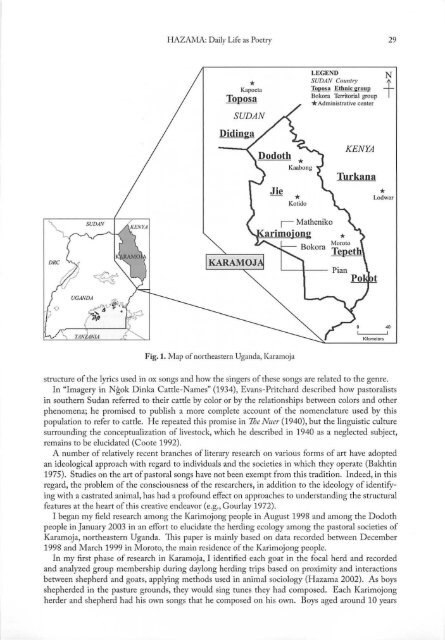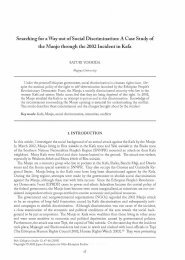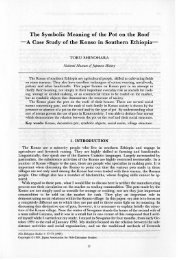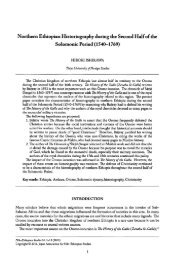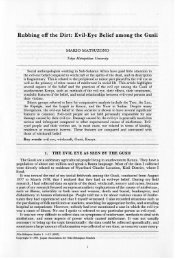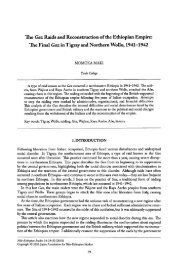Daily Life as Poetry: The Meaning of the Pastoral Songs of the ...
Daily Life as Poetry: The Meaning of the Pastoral Songs of the ...
Daily Life as Poetry: The Meaning of the Pastoral Songs of the ...
Create successful ePaper yourself
Turn your PDF publications into a flip-book with our unique Google optimized e-Paper software.
HAZAMA: <strong>Daily</strong> <strong>Life</strong> <strong>as</strong> <strong>Poetry</strong><br />
29<br />
Kapocta *<br />
Toposa<br />
SUDAN<br />
LEGEND<br />
SUDAN Coumry<br />
Toposa Ethnic group<br />
Bokora Territorial group<br />
* Administrative center<br />
N<br />
t<br />
KENYA<br />
Turkana<br />
Lodwar *<br />
t<br />
Kilometers<br />
40<br />
Fig. 1. Map <strong>of</strong> nor<strong>the</strong><strong>as</strong>tern Uganda, Karamoja<br />
structure <strong>of</strong> <strong>the</strong> lyrics used in ox songs and how <strong>the</strong> singers <strong>of</strong> <strong>the</strong>se songs are related to <strong>the</strong> genre.<br />
In "Imagery in Ngok Dinka Cattle-Names" (1934), Evans-Pritchard described how p<strong>as</strong>toralists<br />
in sou<strong>the</strong>rn Sudan referred to <strong>the</strong>ir cattle by color or by <strong>the</strong> relationships between colors and o<strong>the</strong>r<br />
phenomena; he promised to publish a more complete account <strong>of</strong> <strong>the</strong> nomenclature used by this<br />
population to refer to cattle. He repeated this promise in 7he Nuer (1940), but <strong>the</strong> linguistic culture<br />
surrounding <strong>the</strong> conceptualization <strong>of</strong> livestock, which he described in 1940 <strong>as</strong> a neglected subject,<br />
remains to be elucidated (Coote 1992).<br />
A number <strong>of</strong> relatively recent branches <strong>of</strong> literary research on various forms <strong>of</strong> art have adopted<br />
an ideological approach with regard to individuals and <strong>the</strong> societies in which <strong>the</strong>y operate (Bakhtin<br />
1975). Studies on <strong>the</strong> art <strong>of</strong> p<strong>as</strong>toral songs have not been exempt f rom this tradition. Indeed, in this<br />
regard, <strong>the</strong> problem <strong>of</strong> <strong>the</strong> consciousness <strong>of</strong> <strong>the</strong> researchers, in addition to <strong>the</strong> ideology <strong>of</strong> identifying<br />
with a c<strong>as</strong>trated animal, h<strong>as</strong> had a pr<strong>of</strong>ound effect on approaches to understanding <strong>the</strong> structural<br />
features at <strong>the</strong> heart <strong>of</strong> this creative endeavor (e.g., Gourlay 1972).<br />
I began my field research among <strong>the</strong> Karimojong people in August 1998 and among <strong>the</strong> D odoth<br />
people in January 2003 in an effort to elucidate <strong>the</strong> herdi ng ecology among <strong>the</strong> p<strong>as</strong>toral societies <strong>of</strong><br />
Karamoja, nor<strong>the</strong><strong>as</strong>tern Uganda. This paper is mainly b<strong>as</strong>ed on data recorded between D ecember<br />
1998 and March 1999 in Moroto, <strong>the</strong> main residence <strong>of</strong> <strong>the</strong> Karimojong people.<br />
In my first ph<strong>as</strong>e <strong>of</strong> research in Karamoja, I identified each goat in <strong>the</strong> focal herd and recorded<br />
and analyzed group membership during daylong herding trips b<strong>as</strong>ed on proximity and interactions<br />
between shepherd and goats, applying methods used in animal sociology (Hazama 2002). As boys<br />
shepherded in <strong>the</strong> p<strong>as</strong>ture grounds, <strong>the</strong>y would sing tunes <strong>the</strong>y had composed. Each Karimojong<br />
herder and shepherd had his own songs that he composed on his own. Boys aged around 10 years


